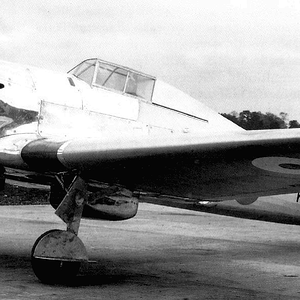Navigation
Install the app
How to install the app on iOS
Follow along with the video below to see how to install our site as a web app on your home screen.
Note: This feature may not be available in some browsers.
More options
You are using an out of date browser. It may not display this or other websites correctly.
You should upgrade or use an alternative browser.
You should upgrade or use an alternative browser.
Design and development
The "J-" designation referred to land-based fighters of the IJN and the "-W-" to Watanabe Tekkōjo, the company that oversaw the initial design; Watanabe changed its name in 1943 to Kyūshū Hikōki K.K.[3][4]
The idea of a canard-based design originated with Lieutenant Commander Masayoshi Tsuruno, of the technical staff of the IJN in early 1943. Tsuruno believed the design could easily be retrofitted with a turbojet, when suitable engines became available.[5][6] His ideas were worked out by the First Naval Air Technical Arsenal (Dai-Ichi Kaigun Koku Gijitsusho), which designed three gliders designated Yokosuka MXY6, featuring canards.[5][7] These were built by Chigasaki Seizo K. K. and one was later fitted with a 22 hp Semi 11 (Ha-90) 4-cylinder air-cooled engine.[8]
The feasibility of the canard design was proven by both the powered and unpowered versions of the MYX6 by the end of 1943,[8] and the Navy were so impressed by the flight testing, they instructed the Kyushu Aircraft Company to design a canard interceptor around Tsuruno's concept. Kyushu was chosen because both its design team and production facilities were relatively unburdened,[8] and Tsuruno was chosen to lead a team from Dai-Ichi Kaigun Koku Gijitsusho to aid Kyushu's design works.[5]
The construction of the first two prototypes started in earnest by June 1944, stress calculations were finished by January 1945,[9] and the first prototype was completed in April 1945. The 2,130 hp Mitsubishi MK9D (Ha-43) radial engine and its supercharger were installed behind the cockpit and drove a six-bladed propeller via an extension shaft. Engine cooling was to be provided by long, narrow, obliquely mounted intakes on the side of the fuselage.[10] It was this configuration that caused cooling problems while running the engine while it was still on the ground. This, together with the unavailability of some equipment parts postponed the first flight of the Shinden.
Even before the first prototype took to the air the Navy had already ordered the J7W1 into production,[10] with quotas of 30 Shinden a month given to Kyushu's Zasshonokuma factory and 120 from Nakajima's Handa plant.[10] It was estimated some 1,086 Shinden could be produced between April 1946 and March 1947.[9]
On 3 August 1945, the prototype first took off, with Tsuruno at the controls, from Itazuke Air Base.[5][11] Two more short flights were made, a total of 45 minutes airborne, by war's end. Flights were successful, but showed a marked torque pull to starboard (due to the powerful engine), some flutter of the propeller blades, and vibration in the extended drive shaft.[
The "J-" designation referred to land-based fighters of the IJN and the "-W-" to Watanabe Tekkōjo, the company that oversaw the initial design; Watanabe changed its name in 1943 to Kyūshū Hikōki K.K.[3][4]
The idea of a canard-based design originated with Lieutenant Commander Masayoshi Tsuruno, of the technical staff of the IJN in early 1943. Tsuruno believed the design could easily be retrofitted with a turbojet, when suitable engines became available.[5][6] His ideas were worked out by the First Naval Air Technical Arsenal (Dai-Ichi Kaigun Koku Gijitsusho), which designed three gliders designated Yokosuka MXY6, featuring canards.[5][7] These were built by Chigasaki Seizo K. K. and one was later fitted with a 22 hp Semi 11 (Ha-90) 4-cylinder air-cooled engine.[8]
The feasibility of the canard design was proven by both the powered and unpowered versions of the MYX6 by the end of 1943,[8] and the Navy were so impressed by the flight testing, they instructed the Kyushu Aircraft Company to design a canard interceptor around Tsuruno's concept. Kyushu was chosen because both its design team and production facilities were relatively unburdened,[8] and Tsuruno was chosen to lead a team from Dai-Ichi Kaigun Koku Gijitsusho to aid Kyushu's design works.[5]
The construction of the first two prototypes started in earnest by June 1944, stress calculations were finished by January 1945,[9] and the first prototype was completed in April 1945. The 2,130 hp Mitsubishi MK9D (Ha-43) radial engine and its supercharger were installed behind the cockpit and drove a six-bladed propeller via an extension shaft. Engine cooling was to be provided by long, narrow, obliquely mounted intakes on the side of the fuselage.[10] It was this configuration that caused cooling problems while running the engine while it was still on the ground. This, together with the unavailability of some equipment parts postponed the first flight of the Shinden.
Even before the first prototype took to the air the Navy had already ordered the J7W1 into production,[10] with quotas of 30 Shinden a month given to Kyushu's Zasshonokuma factory and 120 from Nakajima's Handa plant.[10] It was estimated some 1,086 Shinden could be produced between April 1946 and March 1947.[9]
On 3 August 1945, the prototype first took off, with Tsuruno at the controls, from Itazuke Air Base.[5][11] Two more short flights were made, a total of 45 minutes airborne, by war's end. Flights were successful, but showed a marked torque pull to starboard (due to the powerful engine), some flutter of the propeller blades, and vibration in the extended drive shaft.[








